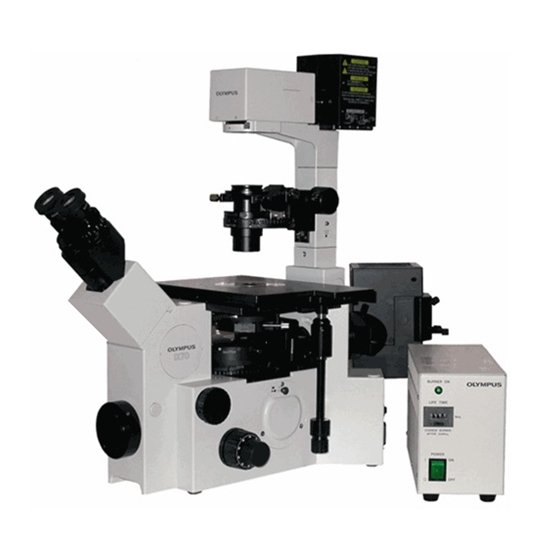Olympus IX70 Panduan Pengoperasian - Halaman 17
Jelajahi secara online atau unduh pdf Panduan Pengoperasian untuk Mikroskop Olympus IX70. Olympus IX70 32 halaman. Inverted fluorescent microscope
Juga untuk Olympus IX70: Petunjuk Pengoperasian (5 halaman)

gives a live stack display. This menu closes after you use it.
The last two items are not general user items. Please don't alter settings. (setting camera to 8-bit
mode can speed data capture, but be kind and restore 12-bit mode IF you use this option).
PDF Created with deskPDF PDF Writer - Trial :: http://www.docudesk.com
Acquire submenus
You should open the Acquire/Acquire menu each session
to access camera controls
You can use the AcquireZseries menu to execute Z stack
collection. You will need to set limits using the Devices/Focus
menu first. This menu closes after you use it.
AcquireMultipleWavelengths permits automated
collection of up to 6 data channels. This menu stays open.
StreamAcquisition collects data as fast as the system can
run. Data is not shown live, but streamed to memory. You can
review it as soon as a run stops.
AcquireTimelapse permits slower image capture and
Devices submenus
Most submenus are not meant for general user modification.
An exception is the FOCUS menu. You can use it to alter the
sensitivity of the focus knob on the microscope. Choosing an
objective does input a preset sensitivity, but if you find the action is
too coarse or fine, select another value from the pulldown list under
the SPECIAL tab. You can use this menu to set the limits for a z-
series collection via the Acquire/AcquireZseries menu. The
Apps/AcquireMultiDimensionalData routine has its own built-in tab
for setting Z limits.
The Configure menus define the microscope settings and
should not be altered. If you need a special setting, ask the staff to
create/modify a custom setting for you.
Display submenus
Most functions to alter the appearance of images are located here. The
AdjustDigitalContrast and ScaleImage menus control the appearance on the
screen (as opposed to data in the image).
See/use the Taskbar shortcut buttons for common operations such as setting
scaling, color, etc.
"Contrast Shortcuts" HERE is archaic and most operations do NOT work for
12-bit image data
Graphics has annotation tools (see below). USE THESE for scalebars and
other calibrations (resist using arrows and text—they are poor quality)
IntensityProfile creates 3D histogram plots of intensity as height
Use OverlayImages to combine dyes and DIC images
ColorCombine is an alternate tool for overlays, esp. good for making RGB
images for true color captures.
ColorAlign corrects chromatic aberrations
17
